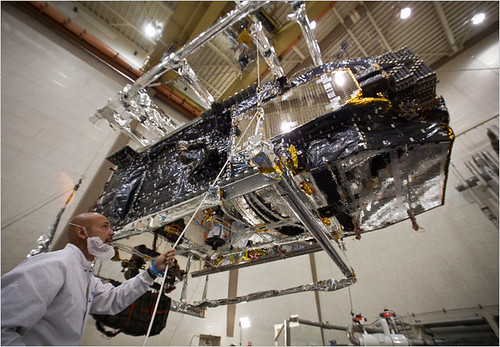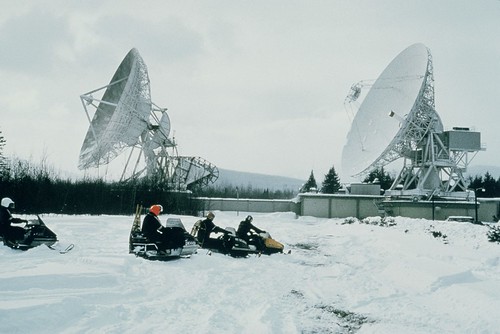EDDE The Garbage Man
Tuesday, August 17th, 2010

Take out your cans, ’cause here come the garbage man!
That’s what Louie, played by Scatman Crothers, would sing when he’d come around the shop on "Chico and The Man," a popular TV show from the 1970s. Over at DARPA, they may call him EDDE these days.
Meet EDDE, the Electrodynamic Debris Eliminator.
EDDE is an operational electrodynamic vehicle proposed by Jerome Pearson of STAR Technology and Research. STAR and TAI have worked on it under AFRL, NASA, NIAC, and DARPA funding, and are about to receive additional funding from DARPA. EDDE spins like a propeller to stabilize itself. The spin also lets EDDE push and pull against the earth’s magnetic field as desired, allowing controlled changes in all 6 orbit elements.
EDDE uses a 30mm wide reinforced aluminum-foil tape as a full-length 10 km electron collector and conductor, to improve electron collection at high altitudes. EDDE’s solar arrays are distributed along its length. They serve as "electron pumping stations" that limit peak voltages relative to the local plasma. They also allow prompt detection and active quenching of arcs triggered by micrometeoroid impact on negatively-biased parts of EDDE, to prevent TSS-like failures due to sustained arcing. Like TEPCE, EDDE can flow current in either direction, but EDDE will use hollow cathodes as electron emitters, to allow multi-amp currents.
EDDE will be able to capture objects in expendable spinning nets deployed from either end, and drag them either down into short-lived orbits, or to facilities that might recycle much of the ~2100 tons of debris now in low earth orbit. Each EDDE weighs ~100 kg and should be able to handle ~25 tons of LEO debris per year. So a dozen EDDEs may be able to clean up most of the 2100 tons of debris in LEO within ~7 years. Thereafter a few EDDEs can stay in orbit to remove new spent stages and failed satellites on demand, providing a new option for complying with the "25-year rule."

This little device may help clean up space junk? Good idea…
Jerome Pearson, president of Star Inc, presented the idea for what he calls "a space garbage truck" on Friday at the annual Space Elevator conference. Pearson was an early proponent of the idea of building a space elevator, and a paper he wrote about it in 1975 inspired the description of a space elevator in Arthur C Clarke’s science fiction book, The Fountains of Paradise, which popularised the idea.
Space garbage happens to be one of the biggest obstacles to building a space elevator. Pearson’s proposed EDDE vehicle will come equipped with around 200 nets, like butterfly nets, that it extends to scoop up garbage in low-earth orbit. Over a period of seven years, 12 EDDE vehicles could capture all 2,465 identified objects over 2 kilograms floating in LEO, Pearson says.
NASA astronaut to use robot arm to repair International Space Station | NASA offers $5 million in prizes for robots, satellites and solar spacecraft | European space telescope spots big empty hole | Space elevator conference calls for more materials science research
Once it captures the object, the EDDE can do several things with it. EDDE can fling the garbage such that it lands in the South Pacific, where it has little chance of dangerously landing on anything important. Or, the EDDE can deliver the object closer to Earth where it will orbit out of harm’s way and eventually decay.
Better yet, it can be reused in space to build a variety of useful structures, Pearson said. "So you’d be mining aluminium in orbit mainly," he said. Four EDDEs could collect enough metal and other material to build a structure the size of the Smithsonian Air and Space Museum, which could be used to host crews or store equipment, he said.
Pearson acknowledges a number of challenges to the idea behind EDDE. For instance, with 12 or more EDDEs zipping around, "we may need space traffic control," he said. Just like the US Federal Aviation Administration regulates US airspace, that agency has already begun looking at ways it might monitor space, requiring vehicles like EDDEs to file flight plans, he said.
Another possibly significant issue is that while Pearson is proposing the use of EDDEs to clean up garbage, they could potentially be used for more sinister purposes, and that has already raised alarms in China. For instance, an EDDE could be used for military purposes to remove a satellite from orbit. Because of those concerns, Space Inc is working on shifting the project to NASA rather than DARPA, which is part of the US Department of Defence, Pearson said.






